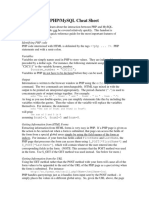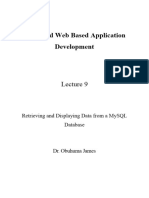EZSQL Overview
Uploaded by
TheScienceOfTimeEZSQL Overview
Uploaded by
TheScienceOfTimeIntroduction
Page 1 of 20
ezSQL Overview download ez_sql.zip
To email the creator: justin_at_visunet_dot_ie
ezSQL is a widget that makes it very fast and easy for you to use database(s) within your
PHP scripts ( mySQL / Oracle8/9 / InterBase/FireBird / PostgreSQL / MS-SQL / SQLite /
SQLite c++).
It is one php file that you include at the top of your script. Then, instead of using standard
php database functions listed in the php manual, you use a much smaller (and easier) set of
ezSQL functions.
It automatically caches query results and allows you to use easy to understand functions to
manipulate and extract them without causing extra server overhead
It has excellent debug functions making it lightning-fast to see whats going on in your SQL
code
Most ezSQL functions can return results as Objects, Associative Arrays, or Numerical
Arrays
It can dramatically decrease development time and in most cases will streamline your code
and make things run faster as well as making it very easy to debug and optimise your
database queries.
It is a small class and will not add very much overhead to your website.
Note: It is assumed that you are familiar with PHP, basic Database concepts and basic SQL
constructs. Even if you are a complete beginner ezSQL can help you once you have read
and understood this tutorial.
Quick Examples..
Note: In all these examples no other code is required other than including ez_sql.php
---------------------------------------------------Example 1
---------------------------------------------------// Select multiple records from the database and print them out..
$users = $db->get_results("SELECT name, email FROM users");
foreach ( $users as $user )
{
// Access data using object syntax
echo $user->name;
echo $user->email;
}
---------------------------------------------------Example 2
---------------------------------------------------// Get one row from the database and print it out..
$user = $db->get_row("SELECT name,email FROM users WHERE id = 2");
echo $user->name;
8/25/2009
Introduction
Page 2 of 20
echo $user->email;
---------------------------------------------------Example 3
---------------------------------------------------// Get one variable from the database and print it out..
$var = $db->get_var("SELECT count(*) FROM users");
echo $var;
---------------------------------------------------Example 4
---------------------------------------------------// Insert into the database
$db->query("INSERT INTO users (id, name, email) VALUES (NULL,'justin','jv@foo.com')");
---------------------------------------------------Example 5
---------------------------------------------------// Update the database
$db->query("UPDATE users SET name = 'Justin' WHERE id = 2)");
---------------------------------------------------Example 6
---------------------------------------------------// Display last query and all associated results
$db->debug();
---------------------------------------------------Example 7
---------------------------------------------------// Display the structure and contents of any result(s) .. or any variable
$results = $db->get_results("SELECT name, email FROM users");
$db->vardump($results);
---------------------------------------------------Example 8
---------------------------------------------------// Get 'one column' (based on column index) and print it out..
$names = $db->get_col("SELECT name,email FROM users",0)
foreach ( $names as $name )
{
echo $name;
}
8/25/2009
Introduction
Page 3 of 20
---------------------------------------------------Example 9
---------------------------------------------------// Same as above but quicker
foreach ( $db->get_col("SELECT name,email FROM users",0) as $name )
{
echo $name;
}
---------------------------------------------------Example 10
---------------------------------------------------// Map out the full schema of any given database and print it out..
$db->select("my_database");
foreach ( $db->get_col("SHOW TABLES",0) as $table_name )
{
$db->debug();
$db->get_results("DESC $table_name");
}
$db->debug();
Introduction
When working with databases most of the time you will want to do one of four types of basic
operations.
1.
2.
3.
4.
Perform a query such as Insert or Update (without results)
Get a single variable from the database
Get a single row from the database
Get a list of results from the database
ezSQL wraps up these four basic actions into four very easy to use functions.
bool $db->query(query)
var
$db->get_var(query)
mixed $db->get_row(query)
mixed $db->get_results(query)
With ezSQL these four functions are all you will need 99.9% of the time. Of course there are
also some other useful functions but we will get into those later.
Important Note: If you use ezSQL inside a function you write, you will need to put global
$db; at the top.
8/25/2009
Introduction
Page 4 of 20
Installation
To install ezSQL download, unzip and install the contents of ez_sql.zip into the same
directory within your web server.
Put the following at the top of your script:
// Include ezSQL core
include_once "ez_sql_core.php";
// Include ezSQL database specific component (in this case mySQL)
include_once "ez_sql_mysql.php";
// Initialise database object and establish a connection
// at the same time - db_user / db_password / db_name / db_host
$db = new ezSQL_mysql('db_user','db_password','db_name','db_host');
Note: On most systems localhost will be fine for the dbhost value. If you are unsure about
any of the above settings you should contact your provider or look through your providers
documentation.
If you are running on a local machine and have just installed mySQL for the first time, you
can probably leave the user name and password empty ( i.e. = ) until you set up a mySQL
user account.
Running the ezSQL demo
Once you have installed ezSQL as described above you can see it in action by running
ez_demo.php via your web browser. To do this simply go to..
http://yourserver.com/install_path/mysql/demo.php
If you are running your web server on your local machine this will be..
http://127.0.0.1/install_path/mysql/demo.php
What the demo does is use ezSQL functions to map out the table structure of your
database (i.e the database you specified at the top of ez_sql.php). You will be surprised how
little code is required to do this when using ezSQL. I have included it here so you can get a
quick feel for the compactness and speed of ezSQL.
<?php
// Include ezSQL core
include_once "ez_sql_core.php";
// Include ezSQL database specific component
include_once "ez_sql_mysql.php";
// Initialise database object and establish a connection
// at the same time - db_user / db_password / db_name / db_host
$db = new ezSQL_mysql('db_user','db_password','db_name','db_host');
$my_tables = $db->get_results("SHOW TABLES",ARRAY_N);
$db->debug();
8/25/2009
Introduction
Page 5 of 20
foreach ( $my_tables as $table )
{
$db->get_results("DESC $table[0]");
$db->debug();
}
?>
The ezSQL demo explained
<?php
This is the standard way to start php executing within your web page.
include_once ez_sql.php;
This is how you include ezSQL in your script. Normally you include it at the top of
your script and from that point forward you have access to any ezSQL function.
$my_tables = $db->get_results(SHOW TABLES,ARRAY_N);
get_results() is how you get a list of things from the database using ezSQL. The list
is returned as an array. In this case the std mySQL command of SHOW TABLES is
called and the resulting list is stored in a newly created array $my_tables.
When using $db->get_results(), if there are any results, they are always returned as
multi-dimensional array. The first dimension is a numbered index. Each of the
numbered indexes is either an object, associative array or numerical array containing
all the values for one row.
For example using the switch ARRAY_A would produce an array that looked
something like this.
$users = $db->get_results(SELECT id,name FROM users,ARRAY_A);
$users[0] = array (id => 1, name => Amy);
$users[1] = array (id => 2, name => Tyson);
If you wanted a numerical array use the switch ARRAY_N.
$users = $db->get_results(SELECT id,name FROM users,ARRAY_N);
$users[0] = array (0 => 1, 1 => Amy);
$users[1] = array (0 => 2, 1 => Tyson);
If you wanted an object (which is the default option) you dont need a switch..
$users = $db->get_results(SELECT id,name FROM users);
$users[0]->id = 1;
$users[0]->name = Amy;
$users[1]->id = 2;
$users[1]->name = Tyson;
Results returned as an object make it very easy to work with database results using
the numerous array functions that php offers. For example, to loop through results
returned as an object all one needs to do is..
$users = $db->get_results(SELECT id,name FROM users);
8/25/2009
Introduction
Page 6 of 20
foreach( $users as $user )
{
echo $user->id;
echo $user->name;
}
If you are 100% sure that there will be results you can skip a step and do this..
foreach( $db->get_results(SELECT id,name FROM users) as $user )
{
echo $user->id;
echo $user->name;
}
If you dont know whether there will be results or not you can do this..
If ( $users= $db->get_results(SELECT id,name FROM users) )
{
foreach( $users as $user )
{
echo $user->id;
echo $user->name;
}
}
else
{
echo No results;
}
$db->debug();
This function prints the most recently called sql query along with a well formatted
table containing any results that the query generated (if any) and the column info.
foreach ( $my_tables as $table)
This is the standard way to easily loop through an array in php. In this case the array
$my_tables was created with the ezSQL command $db->get_results(SHOW
TABLES,ARRAY_N). Because of the ARRAY_N switch the results are returned as a
numerical array.
The resulting array will look something like..
$my_tables[0] = array (0 => users);
$my_tables[1] = array (0 => products);
$my_tables[2] = array (0 => guestbook);
{
The foreach is looping through each primary element of $my_tables[n] which are in
turn numerical arrays, with the format like so..
array(0 => value, 1 => value, etc.);
Thus, during the foreach loop of $my_tables we have access to the value of the first
column like so:
foreach ($my_tables as $table)
{
echo $table[0];
}
8/25/2009
Introduction
Page 7 of 20
If we did the same thing using an associative array it might look like this..
$users = $db->get_results(SELECT id,name FROM users,ARRAY_A);
foreach ( $users as $user )
{
echo $user[id];
echo $user[name];
}
But if there were no results foreach might generate a warning. So a safer way to do
the above is..
if ( $users = $db->get_results(SELECT id,name FROM users,ARRAY_A))
{
foreach ( $users as $user )
{
echo $user[id];
echo $user[name];
}
}
else
{
echo No Users:
}
This works because if no results are returned then get_results() returns false.
$db->get_results(DESC $table[0]);
This database query is nested within the foreach loop. Note that we are using
the results of the previous call to make a new call. Traditionally you would
have to be concerned about using different db_resource identifiers in a case
like this but ezSQL takes care of that for you, making it very easy to nest
database queries.
You may be wondering why I have used a numerical array output and not
object or associative array. The reason is because in this case I do not know
what the name of the first column will be. So I can make sure that I can
always get its value by using numerical array output and targeting the first
column by element [0].
FYI: The SQL command SHOW TABLES always names the first column a
different value depending on the database being used. If the database was
named users the column would be called Tables_in_users if the database
was called customers the column would be called Tables_in_customers
and so on.
$db->debug();
This function will always print the last query and its results (if any) to the
browser. In this case it will be for the above query..
$db->get_results(DESC $table[0]);
You may have noticed that the above get_results function is not assigning a
value. (i.e. $var = val). This is because even if you do not assign the output
value of any ezSQL function the query results are always stored and made
ready for any ezSQL function to use. In this case $db->debug() is displaying
the stored results. Then, by calling any ezSQL function using a null query
you will be accessing the stored results from the last query. Here is a more
8/25/2009
Introduction
Page 8 of 20
detailed example.
Users Table..
amy, amy@foo.com
tyson, tyson@foo.com
// Any ezSQL function will store query results..
$users = $db->get_results(SELECT name,email FROM users);
// This gets a variable from the above results (offset by $x = 1, $y = 1).
echo $db->get_var(null,1,1);
// Note: Because a null query is passed to get_var it uses results from
the previous query.
Output: tyson@foo.com
}
This closes the foreach loop
?>
This stops php executing code
ezSQL functions
$db->get_results -- get multiple row result set from the database (or previously cached results)
$db->get_row -- get one row from the database (or previously cached results)
$db->get_col -- get one column from query (or previously cached results) based on column offset
$db->get_var -- get one variable, from one row, from the database (or previously cached results)
$db->query -- send a query to the database (and if any results, cache them)
$db->debug -- print last sql query and returned results (if any)
$db->vardump -- print the contents and structure of any variable
$db->select -- select a new database to work with
$db->get_col_info -- get information about one or all columns such as column name or type
$db->hide_errors -- turn ezSQL error output to browser off
$db->show_errors -- turn ezSQL error output to browser on
$db->escape -- Format a string correctly to stop accidental mal formed queries under all PHP
conditions
$db = new db -- Initiate new db object.
ezSQL variables
$db->num_rows Number of rows that were returned (by the database) for the last query (if any)
$db->insert_id -- ID generated from the AUTO_INCRIMENT of the previous INSERT operation (if
any)
$db->rows_affected -- Number of rows affected (in the database) by the last INSERT, UPDATE or
DELETE (if any)
$db->num_queries -- Keeps track of exactly how many 'real' (not cached) queries were executed
during the lifetime of the current script
$db->debug_all If set to true (i.e. $db->debug_all = true;) Then it will print out ALL queries and ALL
results of your script.
$db->cache_dir Path to mySQL caching dir.
$db->cache_queries Boolean flag (see mysql/disk_cache_example.php)
$db->cache_inserts Boolean flag (see mysql/disk_cache_example.php)
$db->use_disk_cache Boolean flag (see mysql/disk_cache_example.php)
$db->cache_timeout Number in hours (see mysql/disk_cache_example.php)
8/25/2009
Introduction
Page 9 of 20
$db = new db
$db = new db -- Initiate new db object. Connect to a database server. Select a database.
Description
$db = new db(string username, string password, string database name, string database
host)
Does three things. (1) Initiates a new db object. (2) Connects to a database server. (3)
Selects a database. You can also re-submit this command if you would like to initiate a
second db object. This is interesting because you can run two concurrent database
connections at the same time. You can even connect to two different servers at the same
time if you want to.
Note: For the sake of efficiency it is recommended that you only run one instance of the db
object and use $db->select to switch between different databases on the same server
connection.
Example
// Initiate new database object..
$db2 = new db(user_name, user_password, database_name, database_host);
// Perform some kind of query..
$other_db_tables = $db2->get_results(SHOW TABLES);
// You can still query the database you were already connected to..
$existing_connection_tables = $db->get_results(SHOW TABLES);
// Print the results from both of these queries..
$db->debug();
$db2->debug();
$db->select
$db->select -- select a new database to work with
Description
bool $db->select(string database name)
$db->select() selects a new database to work with using the current database connection
as created with $db = new db.
Example
// Get a users name from the users database (as initiated with $db = new db)..
$user_name = $db->get_var(SELECT name FROM users WHERE id = 22) ;
// Select the database stats..
$db->select(stats);
// Get a users name from the users database..
$total_hours = $db->get_var(SELECT sum(time_logged_in) FROM user_stats WHERE
8/25/2009
Introduction
Page 10 of 20
user = $user_name) ;
// Re-select the users database to continue working as normal..
$db->select(users);
$db->query
$db->query -- send a query to the database (and if any results, cache them)
Description
bool $db->query(string query)
$db->query() sends a query to the currently selected database. It should be noted that you
can send any type of query to the database using this command. If there are any results
generated they will be stored and can be accessed by any ezSQL function as long as you
use a null query. If there are results returned the function will return true if no results the
return will be false
Example 1
// Insert a new user into the database..
$db->query(INSERT INTO users (id,name) VALUES (1,Amy)) ;
Example 2
// Update user into the database..
$db->query(UPDATE users SET name = Tyson WHERE id = 1) ;
Example 3
// Query to get full user list..
$db->query(SELECT name,email FROM users) ;
// Get the second row from the cached results by using a null query..
$user_details = $db->get_row(null, OBJECT,1);
// Display the contents and structure of the variable $user_details..
$db->vardump($user_details);
$db->get_var
$db->get_var -- get one variable, from one row, from the database (or previously cached
results)
Description
var $db->get_var(string query / null [,int column offset[, int row offset])
$db->get_var() gets one single variable from the database or previously cached results.
This function is very useful for evaluating query results within logic statements such as if or
switch. If the query generates more than one row the first row will always be used by
default. If the query generates more than one column the leftmost column will always be
8/25/2009
Introduction
Page 11 of 20
used by default. Even so, the full results set will be available within the array $db>last_results should you wish to use them.
Example 1
// Get total number of users from the database..
$num_users = $db->get_var(SELECT count(*) FROM users) ;
Example 2
// Get a users email from the second row of results (note: col 1, row 1 [starts at 0])..
$user_email = $db->get_var(SELECT name, email FROM users,1,1) ;
// Get the full second row from the cached results (row = 1 [starts at 0])..
$user = $db->get_row(null,OBJECT,1);
// Both are the same value..
echo $user_email;
echo $user->email;
Example 3
// Find out how many users there are called Amy..
if ( $n = $db->get_var(SELECT count(*) FROM users WHERE name = Amy) )
{
// If there are users then the if clause will evaluate to true. This is useful because
// we can extract a value from the DB and test it at the same time.
echo There are $n users called Amy!;
}
else
{
// If there are no users then the if will evaluate to false..
echo There are no users called Amy.;
}
Example 4
// Match a password from a submitted from a form with a password stored in the DB
if ( $pwd_from_form == $db->get_var(SELECT pwd FROM users WHERE name =
$name_from_form) )
{
// Once again we have extracted and evaluated a result at the same time..
echo Congratulations you have logged in.;
}
else
{
// If has evaluated to false..
echo Bad password or Bad user ID;
}
8/25/2009
Introduction
Page 12 of 20
$db->get_row
$db->get_row -- get one row from the database (or previously cached results)
Description
object $db->get_ row(string query / null [, OBJECT / ARRAY_A / ARRAY_N [, int row
offset]])
$db->get_row() gets a single row from the database or cached results. If the query returns
more than one row and no row offset is supplied the first row within the results set will be
returned by default. Even so, the full results will be cached should you wish to use them with
another ezSQL query.
Example 1
// Get a users name and email from the database and extract it into an object called user..
$user = $db->get_row(SELECT name,email FROM users WHERE id = 22) ;
// Output the values..
echo $user->name has the email of $user->email;
Output:
Amy has the email of amy@foo.com
Example 2
// Get users name and date joined as associative array
// (Note: we must specify the row offset index in order to use the third argument)
$user = $db->get_row(SELECT name, UNIX_TIMESTAMP(my_date_joined) as
date_joined FROM users WHERE id = 22,ARRAY_A) ;
// Note how the unix_timestamp command is used with as this will ensure that the resulting
data will be easily
// accessible via the created object or associative array. In this case $user[date_joined]
(object would be $user->date_joined)
echo $user[name] . joined us on . date(m/d/y,$user[date_joined]);
Output:
Amy joined us on 05/02/01
Example 3
// Get second row of cached results.
$user = $db->get_row(null,OBJECT,1) ;
// Note: Row offset starts at 0
echo $user->name joined us on . date(m/d/y,$user->date_joined);
Output:
Tyson joined us on 05/02/02
Example 4
// Get one row as a numerical array..
$user = $db->get_row(SELECT name,email,address FROM users WHERE id =
1,ARRAY_N);
8/25/2009
Introduction
Page 13 of 20
// Output the results as a table..
echo <table>;
for ( $i=1; $i <= count($user); $i++ )
{
echo <tr><td>$i</td><td>$user[$I]</td></tr>;
}
echo </table>;
Output:
1
2
3
amy
amy@foo.com
123 Foo Road
$db->get_results
$db->get_results get multiple row result set from the database (or previously cached
results)
Description
array $db->get_results(string query / null [, OBJECT / ARRAY_A / ARRAY_N ] )
$db->get_row() gets multiple rows of results from the database based on query and returns
them as a multi dimensional array. Each element of the array contains one row of results
and can be specified to be either an object, associative array or numerical array. If no results
are found then the function returns false enabling you to use the function within logic
statements such as if.
Example 1 Return results as objects (default)
Returning results as an object is the quickest way to get and display results. It is also useful
that you are able to put $object->var syntax directly inside print statements without having to
worry about causing php parsing errors.
// Extract results into the array $users (and evaluate if there are any results at the same
time)..
if ( $users = $db->get_results(SELECT name, email FROM users) )
{
// Loop through the resulting array on the index $users[n]
foreach ( $users as $user )
{
// Access data using column names as associative array keys
echo $user->name - $user->email<br>;
}
}
else
{
// If no users were found then if evaluates to false..
echo No users found.;
8/25/2009
Introduction
Page 14 of 20
}
Output:
Amy - amy@hotmail.com
Tyson - tyson@hotmail.com
Example 2 Return results as associative array
Returning results as an associative array is useful if you would like dynamic access to
column names. Here is an example.
// Extract results into the array $dogs (and evaluate if there are any results at the same
time)..
if ( $dogs = $db->get_results(SELECT breed, owner, name FROM dogs, ARRAY_A) )
{
// Loop through the resulting array on the index $dogs[n]
foreach ( $dogs as $dog_detail )
{
// Loop through the resulting array
foreach ( $dogs_detail as $key => $val )
{
// Access and format data using $key and $val pairs..
echo <b> . ucfirst($key) . </b>: $val<br>;
}
// Do a P between dogs..
echo <p>;
}
}
else
{
// If no users were found then if evaluates to false..
echo No dogs found.;
}
Output:
Breed: Boxer
Owner: Amy
Name: Tyson
Breed: Labrador
Owner: Lee
Name: Henry
Breed: Dachshund
Owner: Mary
Name: Jasmine
Example 3 Return results as numerical array
Returning results as a numerical array is useful if you are using completely dynamic
queries with varying column
names but still need a way to get a handle on the results. Here is an example of this
concept in use. Imagine that this
8/25/2009
Introduction
Page 15 of 20
script was responding to a form with $type being submitted as either fish or dog.
// Create an associative array for animal types..
$animal = array ( fish => num_fins, dog => num_legs );
// Create a dynamic query on the fly..
if ( $results = $db->(SELECT $animal[$type] FROM $type,ARRAY_N))
{
foreach ( $results as $result )
{
echo $result[0]<br>;
}
}
else
{
echo No $animal\s!;
}
Output:
4
4
4
Note: The dynamic query would be look like one of the following...
SELECT num_fins FROM fish
SELECT num_legs FROM dogs
It would be easy to see which it was by using $db->debug(); after the dynamic query
call.
$db->debug
$db->debug print last sql query and returned results (if any)
Description
$db->debug(void)
$db->debug() prints last sql query and its results (if any)
Example 1
If you need to know what your last query was and what the returned results are here is how
you do it.
// Extract results into the array $users..
$users = $db->get_results(SELECT name, email FROM users);
// See what just happened!
$db->debug();
8/25/2009
Introduction
Page 16 of 20
$db->vardump
$db->vardump print the contents and structure of any variable
Description
$db->vardump(void)
$db->vardump() prints the contents and structure of any variable. It does not matter what
the structure is be it an object, associative array or numerical array.
Example 1
If you need to know what value and structure any of your results variables are here is how
you do it.
// Extract results into the array $users..
$users = $db->get_results(SELECT name, email FROM users);
// View the contents and structure of $users
$db->vardump($users);
$db->get_col
$db->get_col get one column from query (or previously cached results) based on column
offset
Description
$db->get_col( string query / null [, int column offset] )
$db->get_col() extracts one column as one dimensional array based on a column offset. If
no offset is supplied the offset will defualt to column 0. I.E the first column. If a null query is
supplied the previous query results are used.
Example 1
// Extract list of products and print them out at the same time..
foreach ( $db->get_col(SELECT product FROM product_list) as $product)
{
echo $product;
}
Example 2 Working with cached results
// Extract results into the array $users..
$users = $db->get_results(SELECT * FROM users);
// Work out how many columns have been selected..
$last_col_num = $db->num_cols - 1;
// Print the last column of the query using cached results..
foreach ( $db->get_col(null, $last_col_num) as $last_col )
8/25/2009
Introduction
Page 17 of 20
{
echo $last_col;
}
$db->get_col_info
$db->get_col_info - get information about one or all columns such as column name or type
Description
$db->get_col_info(string info-type[, int column offset])
$db->get_col_info()returns meta information about one or all columns such as column
name or type. If no information type is supplied then the default information type of name is
used. If no column offset is supplied then a one dimensional array is returned with the
information type for all columns. For access to the full meta information for all columns you
can use the cached variable $db->col_info
Available Info-Types
mySQL
name - column name
table - name of the table the column belongs to
max_length - maximum length of the column
not_null - 1 if the column cannot be NULL
primary_key - 1 if the column is a primary key
unique_key - 1 if the column is a unique key
multiple_key - 1 if the column is a non-unique key
numeric - 1 if the column is numeric
blob - 1 if the column is a BLOB
type - the type of the column
unsigned - 1 if the column is unsigned
zerofill - 1 if the column is zero-filled
ibase
name - column name
type - the type of the column
length - size of column
alias - undocumented
relation - undocumented
MS-SQL / Oracle / Postgress
name - column name
type - the type of the column
length - size of column
SQLite
name - column name
8/25/2009
Introduction
Page 18 of 20
Example 1
// Extract results into the array $users..
$users = $db->get_results(SELECT id, name, email FROM users);
// Output the name for each column type
foreach ( $db->get_col_info(name) as $name )
{
echo $name<br>;
}
Output:
id
name
email
Example 2
// Extract results into the array $users..
$users = $db->get_results(SELECT id, name, email FROM users);
// View all meta information for all columns..
$db->vardump($db->col_info);
$db->hide_errors
$db->hide_errors turn ezSQL error output to browser off
Description
$db->hide_errors( void )
$db->hide_errors() stops error output from being printed to the web client. If you would like
to stop error output but still be able to trap errors for debugging or for your own error output
function you can make use of the global error array $EZSQL_ERROR.
Note: If there were no errors then the global error array $EZSQL_ERROR will evaluate to
false. If there were one or more errors then it will have the following structure. Errors are
added to the array in order of being called.
$EZSQL_ERROR[0] = Array
(
[query] => SOME BAD QUERY
[error_str] => You have an error in your SQL syntax near SOME BAD QUERY' at line 1
)
$EZSQL_ERROR[1] = Array
(
[query] => ANOTHER BAD QUERY
[error_str] => You have an error in your SQL syntax near ANOTHER BAD QUERY' at line 1
)
$EZSQL_ERROR[2] = Array
(
[query] => THIRD BAD QUERY
[error_str] => You have an error in your SQL syntax near THIRD BAD QUERY' at line 1
8/25/2009
Introduction
Page 19 of 20
Example 1
// Using a custom error function
$db->hide_errors();
// Make a silly query that will produce an error
$db->query(INSERT INTO my_table A BAD QUERY THAT GENERATES AN ERROR);
// And another one, for good measure
$db->query(ANOTHER BAD QUERY THAT GENERATES AN ERROR);
// If the global error array exists at all then we know there was 1 or more ezSQL errors..
if ( $EZSQL_ERROR )
{
// View the errors
$db->vardump($EZSQL_ERROR);
}
else
{
echo No Errors;
}
$db->show_errors
$db->show_errors turn ezSQL error output to browser on
Description
$db->show_errors( void )
$db->show_errors() turns ezSQL error output to the browser on. If you have not used the
function $db->hide_errors this function (show_errors) will have no effect.
$db->escape
$db->escape Format a string correctly in order to stop accidental mal formed queries under all
PHP conditions.
Description
$db->escape( string )
$db->escape() makes any string safe to use as a value in a query under all PHP conditions. I.E. if
magic quotes are turned on or off. Note: Should not be used by itself to guard against SQL injection
attacks. The purpose of this function is to stop accidental mal formed queries.
Example 1
// Escape and assign the value..
$title = $db->escape(Justins and Amys Home Page);
8/25/2009
Introduction
Page 20 of 20
// Insert in to the DB..
$db->query(INSERT INTO pages (title) VALUES ($title)) ;
Example 2
// Assign the value..
$title = Justins and Amys Home Page;
// Insert in to the DB and escape at the same time..
$db->query(INSERT INTO pages (title) VALUES (. $db->escape($title).)) ;
Disk Caching
ezSQL has the ability to cache your queries which can make dynamic sites run much faster.
If you want to cache EVERYTHING just do..
$db->use_disk_cache = true;
$db->cache_queries = true;
$db->cache_timeout = 24;
For full details and more specific options please see:
mysql/disk_cache_example.php
oracle8_9/disk_cache_example.php
8/25/2009
You might also like
- Zig Ziglars Secrets of Closing The Sale PDF100% (13)Zig Ziglars Secrets of Closing The Sale PDF6 pages
- Oracle Database Administration Interview Questions You'll Most Likely Be Asked: Job Interview Questions SeriesFrom EverandOracle Database Administration Interview Questions You'll Most Likely Be Asked: Job Interview Questions Series5/5 (1)
- An Introduction To The ADOdb Class Library For PHPNo ratings yetAn Introduction To The ADOdb Class Library For PHP127 pages
- Sistemas de Informação e Bases de Dados: PHP and SQLNo ratings yetSistemas de Informação e Bases de Dados: PHP and SQL32 pages
- Lesson-05-PHP-Working-with-Databases-in-PHPNo ratings yetLesson-05-PHP-Working-with-Databases-in-PHP45 pages
- Basic PHP Functions For Using Mysql: Result FunctionNo ratings yetBasic PHP Functions For Using Mysql: Result Function51 pages
- To Light A Fire A Dhamma Discourse: The Venerable Webu SayadawNo ratings yetTo Light A Fire A Dhamma Discourse: The Venerable Webu Sayadaw16 pages
- Valuing A Business - Aswath Damodaran (Small Tutorial)100% (3)Valuing A Business - Aswath Damodaran (Small Tutorial)20 pages
- Oracle Database Administration Interview Questions You'll Most Likely Be Asked: Job Interview Questions SeriesFrom EverandOracle Database Administration Interview Questions You'll Most Likely Be Asked: Job Interview Questions Series
- An Introduction To The ADOdb Class Library For PHPAn Introduction To The ADOdb Class Library For PHP
- Sistemas de Informação e Bases de Dados: PHP and SQLSistemas de Informação e Bases de Dados: PHP and SQL
- Basic PHP Functions For Using Mysql: Result FunctionBasic PHP Functions For Using Mysql: Result Function
- To Light A Fire A Dhamma Discourse: The Venerable Webu SayadawTo Light A Fire A Dhamma Discourse: The Venerable Webu Sayadaw
- Valuing A Business - Aswath Damodaran (Small Tutorial)Valuing A Business - Aswath Damodaran (Small Tutorial)










































































